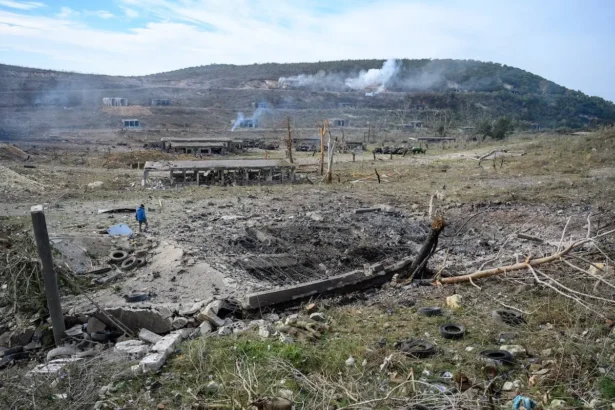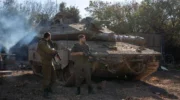Immediately after the Assad regime fell, Israel launched a massive bombing operation targeting the full spectrum of Syria’s military capabilities across the country while beginning a ground incursion along the border with the occupied Golan Heights.
by Walid Al Nofal, reposted from Syria Direct, December 10, 2024
PARIS — As Bashar al-Assad’s regime fell on Sunday, the Israeli military immediately launched a large-scale bombing operation, striking Syrian military assets and airbases across the country, including in areas controlled by the Syrian Democratic Forces (SDF).
At the same time, Tel Aviv’s ground forces pushed into the demilitarized border zone between Syria and the Israeli-occupied Golan Heights, taking control of Mount Hermon and several border areas to a depth of 18 kilometers, including Quneitra city, Baath city and al-Hamidiya.
The operation, dubbed “Bashan Arrow” in reference to a biblical name for southwestern Syria, hit more than 320 targets across Syria in roughly 48 hours, the Israeli military said.
Scientific research centers, military airbases, barracks containing heavy weapons and sites believed to contain chemical weapons were struck in what one Israeli security official called “one of the largest attack operations in the history of the air force.” The Israeli navy also destroyed Syrian navy vessels in both the Latakia and al-Bayda ports.
The Israeli military estimates it has destroyed “more than 70 percent of the former Assad regime’s strategic military capabilities,” the Times of Israel reported on Tuesday, in an effort to prevent “Hezbollah or any hostile force” from reaching them.
‘Decades to rebuild’
At their home in Syria’s southern Daraa province, Abu Muhammad and his family’s initial joy at the fall of the regime was interrupted when “the ground began to violently shake, like an earthquake,” he recalled. Israeli warplanes were striking military sites nearby, in northwestern Daraa.
“The Israeli strikes completely destroyed Syria’s military capability,” one former opposition military commander in Daraa told Syria Direct, asking to remain anonymous. Even “tanks and heavy vehicles were hit in northern Daraa.”
“In the first hours after liberating Daraa province on Sunday, we moved some tanks from one of the brigades to another barracks. The Israeli air force targeted the new location,” he added.
“Israel’s operations destroyed all our weapons, not just strategic weapons,” the commander said. “We need decades to rebuild a national Syrian army.”
Air raids on the Scientific Research Center in the Barzeh area of Damascus on Monday night sparked panic, with activists circulating reports of cases of suffocation due to the release of toxic gases from chemical weapons inside.
The Syrian Civil Defense (White Helmets) denied the existence of toxic gas emissions or cases of suffocation, saying its fire brigades responded to the scene of the strike and put out a fire that broke out as a result.
One media activist living in eastern Daraa told Syria Direct his aunt’s family in Barzeh suffered from suffocation after the strike and “fled the neighborhood afterwards, afraid of repeated bombardment.”
“They do not know if it was from inhaling chemical gasses emitted when the place was targeted, or from the bombing itself,” he said, adding he was in direct contact with his relatives at the time.
Israel’s foreign minister, Gideon Sa’ar, confirmed on Monday that his country struck sites in Syria suspected of containing chemical weapons and long-range missiles to prevent them from falling into “the hands of extremists,” as he put it.
On Monday, Deputy Pentagon Press Secretary Sabrina Singh told reporters the United States (US)—a close ally of Israel—was trying, “through the work of our other partners…to make sure that those chemical weapons do not fall into the hands of anyone that would want to use them against civilians or against our US forces or partners in the region.” Singh declined to specify which partners she was referring to.
1974 agreement ‘collapses’
After Assad fell and Tel Aviv’s troops entered the demilitarized zone bordering the occupied Golan Heights on Sunday, Israeli Prime Minister Benjamin Netanyahu declared the 1974 disengagement agreement between the two countries had “collapsed” and confirmed he ordered his troops to seize the buffer zone.
Damascus and Tel Aviv reached an armistice agreement in 1974 under which Israel withdrew from all areas it occupied during the 1973 war and some areas it occupied in 1967.
The parties agreed to establish a roughly 75-kilometer buffer zone within Syrian territory along the border strip: from Mount Hermon in the north to the Syrian-Jordanian-Israeli border triangle in the south, with a width ranging from 200 meters to 10 kilometers. Syria assumed civil administration of the area, with no military presence, while the United Nations Disengagement Observer Force (UNDOF) was deployed to maintain the ceasefire.
Israel’s current position on the 1974 agreement appears contradictory. Israel’s ambassador to the UN, Danny Danon, wrote in a letter to the Security Council on Monday that his country was taking “limited and temporary measures” in the demilitarized zone and remained committed to the disengagement agreement, contrary to Netanyahu’s remarks.
The Israeli military took a similar approach, calling its incursion in Syria “a defensive and temporary measure” while qualifying that it “may end up staying there for the foreseeable future, depending on developments,” the Times of Israel reported on Tuesday.
So far, Hayat Tahrir al-Sham (HTS)—the largest military entity that participated in the opposition offensive leading to the fall of the Assad regime—has not commented on Israel’s incursion or strikes. Its affiliated Salvation Government, which is heading the transitional phase in Syria, has also had no reaction.
“The recent Israeli advance in Syrian territory is temporary, until the security situation is reorganized and the government takes over the border points,” one source close to HTS leadership told Syria Direct on condition of anonymity. “There is a possibility of renewing the 1974 agreement,” he noted.
However, a military source from the Southern Operations Room—which includes a range of local military groups and former opposition factions in Daraa—said he worries about a continued ground advance by Israeli forces. He expected Tel Aviv would continue to advance to Tal al-Hara, a strategic hill in the northern Daraa countryside.
“Russia used Tal al-Hara as an observation point for the Israeli interior before it withdrew,” he said. “Today, Israel may use it as an advanced observation point.”
Walid Al Nofal is a journalist with Syria Direct originally from Daraa province in southern Syria. He worked as a field reporter shortly after the Syrian revolution began in 2011 until he moved to Jordan in 2013. Today, Walid’s work focuses on documenting humanitarian violations committed by various actors in the Syrian conflict.
This report was originally published in Arabic and translated into English by Mateo Nelson.
RELATED ARTICLES:
- Neocons Try Again in Syria
- WATCH: The Israeli Hit List – Iran Remains
- Israel Expands Invasion of Syria, Launching Massive Airstrikes After Assad’s Fall
- Israeli plans to seize land in Syrian Golan Heights for ‘greenwashing’ wind farm
- Trump responds to Israeli complaints about US troops exiting Syria: We give Israel $4.5 billion
- Trump’s Syria Withdrawal Enrages Pro-Israel Chickenhawks
- Bolton, in Israel, torpedoes Trump’s Syria troop withdrawal
- False claims against Syria lay the groundwork to destroy more Israeli targets
- The Tablet reports that Trump’s approach to Iran, Syria, & Israel looks a lot like Obama’s, because the same people are implementing it




